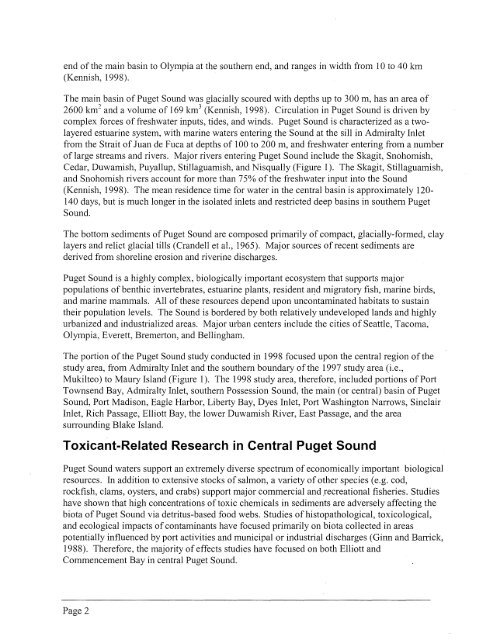Sediment Quality in Puget Sound Year 2 - Center for Coastal ...
Sediment Quality in Puget Sound Year 2 - Center for Coastal ...
Sediment Quality in Puget Sound Year 2 - Center for Coastal ...
You also want an ePaper? Increase the reach of your titles
YUMPU automatically turns print PDFs into web optimized ePapers that Google loves.
end of the ma<strong>in</strong> bas<strong>in</strong> to Olympia at the southern end, and ranges <strong>in</strong> width from 10 to 40 km<br />
(Kennish, 1998).<br />
The ma<strong>in</strong> bas<strong>in</strong> of <strong>Puget</strong> <strong>Sound</strong> was glacially scoured with depths up to 300 m, has an area of<br />
2600 km' and a volume of 169 km3 (Kennish, 1998). Circulation <strong>in</strong> <strong>Puget</strong> <strong>Sound</strong> is driven by<br />
complex <strong>for</strong>ces of freshwater <strong>in</strong>puts, tides, and w<strong>in</strong>ds. <strong>Puget</strong> <strong>Sound</strong> is characterized as a two-<br />
layered estuar<strong>in</strong>e system, with mar<strong>in</strong>e waters enter<strong>in</strong>g the <strong>Sound</strong> at the sill <strong>in</strong> Admiralty Inlet<br />
from the Strait of Juan de Fuca at depths of 100 to 200 m, and freshwater enter<strong>in</strong>g from a number<br />
of large streams and rivers. Major rivers enter<strong>in</strong>g <strong>Puget</strong> <strong>Sound</strong> <strong>in</strong>clude the Skagit, Snohomisl~,<br />
Cedar, Duwamish, Puyallup, Stillaguamish, and Nisqually (Figure 1). The Skagit, Stillaguamish,<br />
and Snohomish rivers account <strong>for</strong> more than 75% of the freshwater <strong>in</strong>put <strong>in</strong>to the <strong>Sound</strong><br />
(Kennish, 1998). The mean residence time <strong>for</strong> water <strong>in</strong> the central bas<strong>in</strong> is approximately 120-<br />
140 days, but is much longer <strong>in</strong> the isolated <strong>in</strong>lets and restricted deep bas<strong>in</strong>s <strong>in</strong> southern <strong>Puget</strong><br />
<strong>Sound</strong>.<br />
The bottom sediments of <strong>Puget</strong> <strong>Sound</strong> are composed primarily of compact, glacially-<strong>for</strong>med, clay<br />
layers and relict glacial tills (Crandell et al., 1965). Major sources of recent sediments are<br />
derived from shorel<strong>in</strong>e erosion and river<strong>in</strong>e discharges.<br />
<strong>Puget</strong> <strong>Sound</strong> is a highly complex, biologically important ecosystem that supports major<br />
populations of benthic <strong>in</strong>vertebrates, estuar<strong>in</strong>e plants, resident and migratory fish, mar<strong>in</strong>e birds,<br />
and mar<strong>in</strong>e mammals. All of these resources depend upon uncontam<strong>in</strong>ated habitats to susta<strong>in</strong><br />
their population levels. The <strong>Sound</strong> is bordered by both relatively undeveloped lands and highly<br />
urbanized and <strong>in</strong>dustrialized areas. Major urban centers <strong>in</strong>clude the cities of Seattle, Tacoma,<br />
Olympia, Everett, Bremerton, and Bell<strong>in</strong>gham.<br />
The portion of the <strong>Puget</strong> <strong>Sound</strong> study conducted <strong>in</strong> 1998 focused upon the central region of the<br />
study area, from Admiralty Inlet and the southern boundary of the 1997 study area (i.e.,<br />
Mukilteo) to Maury Island (Figure 1). The 1998 study area, there<strong>for</strong>e, <strong>in</strong>cluded portions of Port<br />
Townsend Bay, Admiralty Inlet, southern Possession <strong>Sound</strong>, the ma<strong>in</strong> (or central) bas<strong>in</strong> of <strong>Puget</strong><br />
<strong>Sound</strong>, Port Madison, Eagle Harbor, Liberty Bay, Dyes Inlet, Port Wash<strong>in</strong>gton Narrows, S<strong>in</strong>clair<br />
Inlet, Rich Passage, Elliott Bay, the lower Duwamish River, East Passage, and the area<br />
surround<strong>in</strong>g Blake Island.<br />
Toxicant-Related Research <strong>in</strong> Central <strong>Puget</strong> <strong>Sound</strong><br />
<strong>Puget</strong> <strong>Sound</strong> waters support an extremely diverse spectrum of economically important biological<br />
resources. In addition to extensive stocks of salmon, a variety of other species (e.g. cod,<br />
rockfish, clams, oysters, and crabs) support major commercial and recreational fisheries. Studies<br />
have shown that high concentrations of toxic chemicals <strong>in</strong> sediments are adversely affect<strong>in</strong>g the<br />
biota of <strong>Puget</strong> <strong>Sound</strong> via detritus-based food webs. Studies of histopathological, toxicological,<br />
and ecological impacts of contam<strong>in</strong>ants have focused primarily on biota collected <strong>in</strong> areas<br />
potentially <strong>in</strong>fluenced by port activities and municipal or <strong>in</strong>dustrial discharges (G<strong>in</strong>n and Barrick,<br />
1988). There<strong>for</strong>e, the majority of effects studies have focused on both Elliott and<br />
Commencement Bay <strong>in</strong> central <strong>Puget</strong> <strong>Sound</strong>.<br />
Page 2







